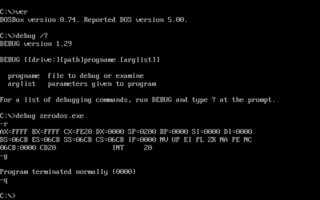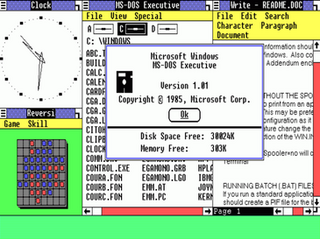Related Research Articles
VBScript is an Active Scripting language developed by Microsoft that is modeled on Visual Basic. It allows Microsoft Windows system administrators to generate powerful tools for managing computers with error handling, subroutines, and other advanced programming constructs. It can give the user complete control over many aspects of their computing environment.

A debugger or debugging tool is a computer program used to test and debug other programs. The main use of a debugger is to run the target program under controlled conditions that permit the programmer to track its operations in progress and monitor changes in computer resources that may indicate malfunctioning code. Typical debugging facilities include the ability to run or halt the target program at specific points, display the contents of memory, CPU registers or storage devices, and modify memory or register contents in order to enter selected test data that might be a cause of faulty program execution.
A terminate-and-stay-resident program is a computer program running under DOS that uses a system call to return control to DOS as though it has finished, but remains in computer memory so it can be reactivated later. This technique partially overcame DOS's limitation of executing only one program, or task, at a time. TSRs are used only in DOS, not in Windows.

Video Graphics Array (VGA) is a video display controller and accompanying de facto graphics standard, first introduced with the IBM PS/2 line of computers in 1987, which became ubiquitous in the PC industry within three years. The term can now refer to the computer display standard, the 15-pin D-subminiature VGA connector, or the 640×480 resolution characteristic of the VGA hardware.
The Graphics Device Interface (GDI) is a legacy component of Microsoft Windows responsible for representing graphical objects and transmitting them to output devices such as monitors and printers. Windows apps use Windows API to interact with GDI, for such tasks as drawing lines and curves, rendering fonts, and handling palettes. The Windows USER subsystem uses GDI to render such UI elements as window frames and menus. Other systems have components that are similar to GDI; for example: macOS has Quartz and X.Org Server has X Window System.
Microsoft Visual C++C) is a compiler for the C, C++ and C++/CX programming languages by Microsoft. MSVC is proprietary software; it was originally a standalone product but later became a part of Visual Studio and made available in both trialware and freeware forms. It features tools for developing and debugging C++ code, especially code written for the Windows API, DirectX and .NET.
NTLDR is the boot loader for all releases of Windows NT operating system up to and including Windows XP and Windows Server 2003. NTLDR is typically run from the primary hard disk drive, but it can also run from portable storage devices such as a CD-ROM, USB flash drive, or floppy disk. NTLDR can also load a non NT-based operating system given the appropriate boot sector in a file.

In DOS memory management, conventional memory, also called base memory, is the first 640 kilobytes of the memory on IBM PC or compatible systems. It is the read-write memory directly addressable by the processor for use by the operating system and application programs. As memory prices rapidly declined, this design decision became a limitation in the use of large memory capacities until the introduction of operating systems and processors that made it irrelevant.

In computing, text-based user interfaces (TUI), is a retronym describing a type of user interface (UI) common as an early form of human–computer interaction, before the advent of graphical user interfaces (GUIs). Like GUIs, they may use the entire screen area and accept mouse and other inputs. They may also use color and often structure the display using special graphical characters such as ┌ and ╣, referred to in Unicode as the "box drawing" set. The modern context of use is usually a terminal emulator.

TopView is the first object-oriented, multitasking, and windowing, personal computer operating environment for PC DOS developed by IBM, announced in August 1984 and shipped in March 1985. TopView provided a text-mode operating environment that allowed users to run more than one application at the same time on a PC. IBM demonstrated an early version of the product to key customers before making it generally available, around the time they shipped their new PC AT computer.

Windows Console is the infrastructure for console applications in Microsoft Windows. An instance of a Windows Console has a screen buffer and an input buffer. It allows console apps to run inside a window or in hardware text mode. The user can switch between the two using the Alt+↵ Enter key combination. The text mode is unavailable in Windows Vista and later. Starting with Windows 10, however, a native full-screen mode is available.

Mathomatic is a free, portable, general-purpose computer algebra system (CAS) that can symbolically solve, simplify, combine, and compare algebraic equations, and can perform complex number, modular, and polynomial arithmetic, along with standard arithmetic. It does some symbolic calculus, numerical integration, and handles all elementary algebra except logarithms. Trigonometric functions can be entered and manipulated using complex exponentials, with the GNU m4 preprocessor. Not currently implemented are general functions like f(x), arbitrary-precision and interval arithmetic, and matrices.

The line-oriented debugger DEBUG is an external command in operating systems such as DOS, OS/2 and Windows.
The Microsoft Windows operating system supports a form of shared libraries known as "dynamic-link libraries", which are code libraries that can be used by multiple processes while only one copy is loaded into memory. This article provides an overview of the core libraries that are included with every modern Windows installation, on top of which most Windows applications are built.

Windows 1.0 is a graphical operating environment for personal computers, developed by Microsoft. Microsoft had worked with Apple Computer to develop applications for Apple's 1984 original Macintosh, the first mass-produced personal computer with a graphical user-interface (GUI) that enabled users to see user-friendly icons on screen. Microsoft released Windows 1.0 on November 20, 1985, as the first version of the Microsoft Windows line. It is a type of software that runs as a graphical, 16-bit multi-tasking shell on top of an existing MS-DOS installation, providing an environment which can run graphical programs designed for Windows, as well as existing MS-DOS software. Microsoft's founder Bill Gates spearheaded the development of Windows 1.0 after he saw a demonstration of a similar software suite, Visi On, at COMDEX in 1982.
The LLDB Debugger (LLDB) is the debugger component of the LLVM project. It is built as a set of reusable components which extensively use existing libraries from LLVM, such as the Clang expression parser and LLVM disassembler. LLDB is free and open-source software under the University of Illinois/NCSA Open Source License, a BSD-style permissive software license. Since v9.0.0, it was relicensed to the Apache License 2.0 with LLVM Exceptions.

Mono is a free and open-source .NET Framework-compatible software framework. Originally by Ximian, it was later acquired by Novell, and is now being led by Xamarin, a subsidiary of Microsoft and the .NET Foundation. Mono can be run on many software systems.
References
- ↑ "CodeView 3.x". WinWorld.
- 1 2 Microsoft Macro Assembler 5.1 - Microsoft CodeView and Utilities. Microsoft Corporation. 1987. p. 157. Document No. 4108-40010-500-R03-1287.
- ↑ Par, Jeff (2018-02-25). "A Short History of SYMDEB". PCjs Machines. Retrieved 2019-05-19.
- ↑ "SYMDEB: A step up from Debug". PC World . 1986-10-14. p. 296.
- ↑ "SYMDEB". PC Magazine . Vol. 5 no. 17. Ziff Davis, Inc. 1986-09-30. p. 38. ISSN 0888-8507.
- ↑ "MS C 4.0 Documentation Added". OS2museum.com.
- ↑ "CodeView Type Records — LLVM 13 documentation". llvm.org. Retrieved 2021-12-19.